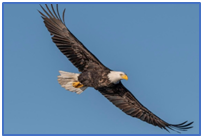Why in news?
- The American bald eagle was removed from the United States’ list of endangered species in June 2007.Since then, the population of the bird has steadily risen.
- A 2021 report by the US Fish and Wildlife Service said that the number of bald eagles in the wild has quadrupled since 2009.
- Once endangered due to habitat loss, hunting, and the pesticide DDT, bald eagles have made a remarkable recovery in recent decades.
What’s in today’s article?
American bald eagle
- About

- Bald eagle, the only eagle solely native to North America.
- It has been the national emblem of the United States since 1782 and a spiritual symbol for native people for far longer than that.
- In 1782, it was first placed with outspread wings on the country’s Great Seal as a sign of strength.
- Features
- Bald eagles are large, predatory raptors that are recognizable for their brown body and wings, white head and tail, and hooked yellow beak.
- Their feet, which are also yellow, are equipped with sharp black talons.
- Juvenile bald eagles look very different from adults—they are almost entirely brown, with occasional white markings on the undersides of their wings and chest.
- Bald eagles grow to about 2.5 to 3 feet (0.7 to 0.9 meters) in height, and they have an impressive wingspan of 6.5 feet (two meters).
- Female bald eagles are larger than the males, but share the same coloration.
- Habitat range
- Bald eagles are North American birds. Their range extends from the Mexico border through the United States and Canada.
- The birds are extremely populous in Alaska.
- They can be seen year-round in Alaska, along the East and West coasts, the Rocky Mountains, and the Mississippi River.
- The rest of the United States only sees bald eagles during the winter and their migration.
- Food
- Bald eagles love fish. These birds are opportunistic predators.
- When fish are not available, they will eat whatever they can catch, including small birds and rodents.
- Bald eagles are also scavengers that will feed on carrion. If they see an opportunity, bald eagles may even steal food from other birds such as osprey.
- Life history
- Bald eagles are solitary, but monogamous animals. Although they spend winters and migrations alone, bald eagles maintain the same breeding pair year after year.
- Conservation status
- The bald eagle was previously listed under the Endangered Species Act, but was delisted in 2007 due to recovery efforts.
- IUCN Status - Least Concern
News Summary
Population decline since the 1800s
- Statistics
- Once upon a time, bald eagles were abundant across the United States.
- When they were adopted as the country’s national symbol in 1782, there were as many as 100,000 nesting birds in the continental United States (including Alaska).
- However, their populations began to decline in the early 1800s.
- Reasons for the decline
- Hunting
- Bald eagles began to be seen as a threat to livestock, especially domestic chicken, and started to be hunted.
- Hunting intensified in the latter half of the century, when feather hats became a fashion staple.
- Appearance of DDT
- DDT or dichloro-diphenyl-trichloroethane was first synthesised in 1874.
- However, in 1939, it was first promoted as an insecticide and began to be used to kill malaria carrying mosquitos and agricultural pests.
- While extremely effective as an insecticide, DDT had a catastrophic impact on the bald eagle population.
Steps taken to protect the bird
- Role of Rachel Carson’s book Silent Spring
- This book, for the first time, documented the detrimental effects of chemical pesticides on the environment.
- It meticulously described how DDT was the prime cause behind the decline in bald eagle populations.
- Ban on the use of DDT for agricultural use
- A nationwide ban on the use of DDT for agricultural use was introduced in 1972.
- Introduction of Endangered Species Act in 1973
- This act broadened protections already in place for endangered species, particularly focussing on protection of animal habitats.
- The bald eagle was one of the original species listed for protection under this act.
- Captive breeding programmes and strict habitat protections
- Captive breeding programmes were launched in the 1970s and proved to be crucial in helping the resurgence of bald eagles.
- A practice known as hacking was commonly used by conservationists.
- Hacking is a controlled way to raise and release bald eagles into a wild viable environment from artificial nesting towers.
- This method simulates a wild eagle nesting site and aids in recovery in an area where re-population is desirable.
- Strict restrictions were brought in with regards to human activity around eagle nests or known nesting areas.










